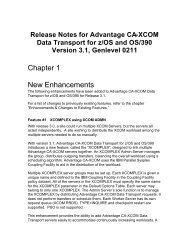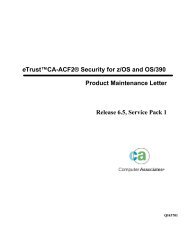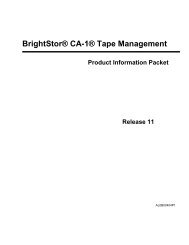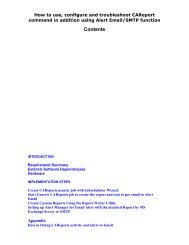eTrust CA-Top Secret Security for z/OS and OS ... - SupportConnect
eTrust CA-Top Secret Security for z/OS and OS ... - SupportConnect
eTrust CA-Top Secret Security for z/OS and OS ... - SupportConnect
- No tags were found...
Create successful ePaper yourself
Turn your PDF publications into a flip-book with our unique Google optimized e-Paper software.
z/<strong>OS</strong> <strong>and</strong> <strong>OS</strong>/390 <strong>Security</strong> Server SupportDCE <strong>Security</strong> ServerThe DCE <strong>Security</strong> Server is a separate security product that providesauthentication services <strong>for</strong> users <strong>and</strong> servers running DCE applications.In a DCE environment, one DCE <strong>Security</strong> Server must exist. A DCE securityserver provides a central hub <strong>for</strong> system entry validation <strong>and</strong> single-sign onauthentication <strong>for</strong> all DCE plat<strong>for</strong>ms within a connected DCE environment. Akey concept of a DCE security server is that it provides an independent orso-called third-party plat<strong>for</strong>m in which to validate <strong>and</strong> authenticate securityrequests. This concept provides obvious security advantages.For example, when a user passes from one DCE plat<strong>for</strong>m to another, the targetplat<strong>for</strong>m passes in<strong>for</strong>mation about the user (so-called user credentials) alongwith other in<strong>for</strong>mation to the DCE security server <strong>for</strong> authentication <strong>and</strong>authorization. The DCE security server authenticates such requests by checkingthe supplied user credentials against those stored in the DCE security server'ssecurity repository <strong>and</strong>/or security registry. In per<strong>for</strong>ming this authentication,the DCE security server follows an authentication algorithm, which involves notonly the user credentials but also involves encryption keys known <strong>for</strong> eachplat<strong>for</strong>m. The algorithm is st<strong>and</strong>ards-based <strong>and</strong> is plat<strong>for</strong>m independent. As aresult, multiple vendors <strong>and</strong> plat<strong>for</strong>ms offer a DCE security server.IBM's z/<strong>OS</strong> <strong>and</strong> <strong>OS</strong>/390 OE/DCE <strong>Security</strong> Server product allows an IBMmainframe to per<strong>for</strong>m these functions.With z/<strong>OS</strong> <strong>and</strong> <strong>OS</strong>/390 O/E DCE security server, <strong>eTrust</strong> <strong>CA</strong>-<strong>Top</strong> <strong>Secret</strong> isutilized mainly to act as a repository <strong>for</strong> in<strong>for</strong>mation needed to support the DCEauthentication process. In particular, the <strong>eTrust</strong> <strong>CA</strong>-<strong>Top</strong> <strong>Secret</strong> is used to holdDCE-specific userid in<strong>for</strong>mation <strong>and</strong> encryption keys. Most notably, a 'DCEsegment' can now be defined <strong>for</strong> any userid. The DCE userid segment allows sixDCE-specific fields to be maintained <strong>for</strong> any userid. For example, one fieldnamed DCEKEY identifies each user's DCE password. During authentication, theDCE security server retrieves this <strong>and</strong> other in<strong>for</strong>mation from <strong>eTrust</strong> <strong>CA</strong>-<strong>Top</strong><strong>Secret</strong> following <strong>for</strong>mal SAF interfaces. This in<strong>for</strong>mation is then used separatelyto authenticate <strong>and</strong> authorize the DCE security server request. As stated, <strong>eTrust</strong><strong>CA</strong>-<strong>Top</strong> <strong>Secret</strong> acts mainly as a repository <strong>for</strong> DCE in<strong>for</strong>mation.<strong>eTrust</strong> <strong>CA</strong>-<strong>Top</strong> <strong>Secret</strong> provides <strong>for</strong> the following functions:■■■■support <strong>for</strong> the DCE segment <strong>for</strong> any userid;support <strong>for</strong> the KEYSMSTR resource class used to hold keys <strong>for</strong> DCEpassword encryption;support <strong>for</strong> the DCEUUIDS resclass used to track the correspondencebetween z/<strong>OS</strong> or <strong>OS</strong>/390 userids <strong>and</strong> DCE UIDs;support <strong>for</strong> four new callable services used to exchange in<strong>for</strong>mation betweenthe ESM <strong>and</strong> the DCE security server.1–96 Cookbook
















